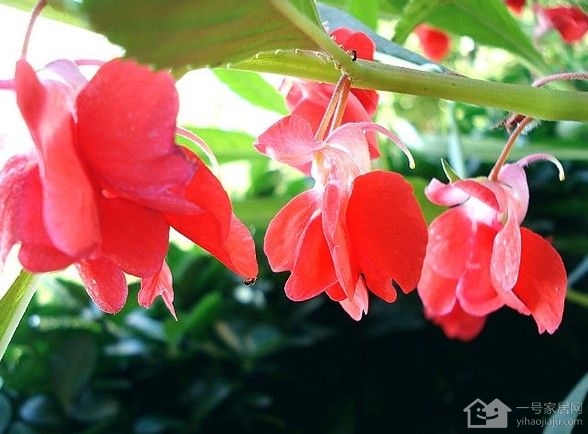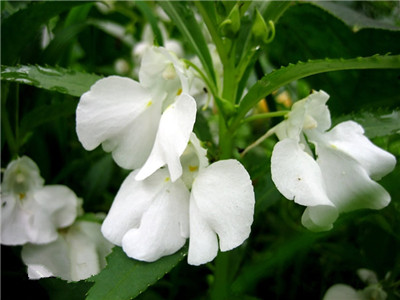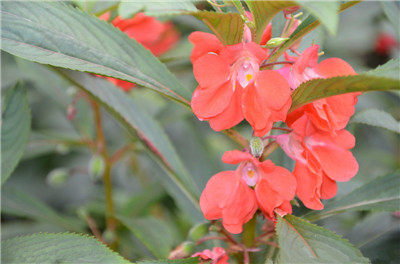How to cultivate impatiens?
Chairman Mao once said in the poem "chanting henna", "I only love my fingernails, so my ambition is stronger." Impatiens is easy to grow and not easy to wither, with strong survival and good adaptability. It does not choose the environment,-people are free to sow a few seeds into the mud. As long as there is water and no fertilizer is needed, they will break the soil and grow. Its stems and leaves are thick and moist, and the flowers are so complex that even if they are planted in broken washbasins and pots, they can create a small crimson and pale landscape on the windowsill in the corner. Therefore, many flower growers like to plant impatiens on their own courtyard or balcony.
Although impatiens has strong life and good adaptability, it should pay attention to the following aspects when cultivating it:
The main results are as follows: 1. The choice of cultivation site: impatiens is sunny, afraid of humidity, heat-resistant and not cold-resistant, suitable for growing in loose, fertile and slightly acidic soil, but also resistant to barren. Therefore, impatiens should be cultivated in places with better light.
2. Selection of cultivation time: impatiens is seed reproduction. Sowing from March to September, sowing in April is the most suitable, transplanting does not choose the time. The growing period is from April to September, and the leaves sprout about a week after the seeds are sown in the basin. It can be sown in the seedbed or directly in the courtyard flower bed. The seedlings grew fast and should be planted in the garden at the beginning of June after one transplant. If the sowing is postponed, the seedlings will be pots and can blossom on National Day.
3. Light and temperature: impatiens like light and receive at least four hours of scattered sunlight every day. However, can not long hot sun exposure, summer, should pay attention to shade; suitable growth temperature of 16-26 degrees Celsius, flowering environment temperature should be controlled above 10 degrees Celsius. Enter the greenhouse in winter to prevent the cold.

About impatiens
Impatiens stem is 40ml / 100cm high, fleshy, stout, erect. Upper part of branches, pilose or nearly smooth. Leaves alternate, broad or narrowly lanceolate, about 10 cm long, apex acuminate, margin acute, base cuneate; there are several pairs of glands near petiole. Its flowers are shaped like butterflies, and their colors are pink, bright red, purple, white and yellow, sprinkling gold and so on. Some varieties can have flowers of several colors on the same plant. According to the ancient flower spectrum, there are more than 200 varieties of impatiens, many of which have been lost. According to the different flower patterns, it can be divided into rose type, camellia type, carnation type and so on.
The flowering period of impatiens is from June to August, and the capsule is fusiform, with white hairs, and the peach-shaped peach-shaped peach-
Impatiens like sunshine, afraid of dampness, heat and cold resistance. Sunny terrain and loose and fertile soil can also grow in poorer soil. Impatiens has strong survivability and good adaptability, and generally has few diseases and insect pests. If the temperature and humidity are high and powdery mildew occurs, you can use 50% carbendazim wettable powder 800 times liquid spray to control. If leaf spot occurs, it can be controlled with 50% carbendazim wettable powder 500 times. The main pest of impatiens is the red diamondback moth, whose larvae will eat the leaves of Phoenix immortal. If this pest is found, it can be captured and eliminated manually. Impatiens is usually sown in March-April in spring. It is suggested that it is best to sow in April and then sow after the temperature picks up.
Second, the function of impatiens.
Impatiens seed, also known as impatiens, stem also known as bone grass, can be used in medicine, has the effect of promoting blood circulation and removing blood stasis, diuresis and detoxification, and passing through the bone. External application of smashed fresh grass can treat sores, furuncles, swelling and pain, poisonous insect bites. The seed is an antidote, which has the effects of menstruation, induced labor, expectoration and accumulation, which should not be taken by pregnant women; the whole grass mash juice, external use to treat injury, petals mashed after increasing garlic juice and other viscous matter, can dye nails, nails can be cured after several times. Seeds contain saponins, fatty oils, sterols, polysaccharides, proteins, amino acids and volatile oils. It is cultivated in the north and south provinces of our country; it can be used for ornamental, not only for flower border and bonsai devices, but also for cut flowers.
Impatiens flowers into medicine, has the effect of promoting blood circulation and detumescence, the treatment of injury, but also can use flowers to treat body odor, about to smash flowers for external application. Impatiens seeds can also be used as medicine, impatiens seeds can treat numbness and soreness, promote blood circulation and dredge menstruation, and can also be used to remove rheumatism, which is very effective in the treatment of rheumatoid arthritis, bite, tinea of the hand and so on.
Impatiens can be used as medicine for the whole plant, especially seeds and flowers. Impatiens can be used for women's amenorrhea. The general usage is to soak about 4 balsam flowers, soak them in water and drink. Impatiens is used to treat the injury caused by falling. The usage is to dry the roots of impatiens, rinse with water, or mash the stems and leaves of impatiens into juice and rinse them with yellow rice wine. Balsamine is used to treat edema, the general usage is to use it in cooking, that is, stewing balsam with pork can reduce swelling; balsam is used to treat hematemesis and hemoptysis, the general usage is to fry impatiens more than 10 times with water; balsamine is used to treat gray fingernails and goose palm wind. The general usage is to mash the balsam and apply it externally.
Third, how to plant impatiens seeds
1. Find a piece of loose, fertile, slightly sour soil, or a container such as a flowerpot, and put about 80% of the loose soil in the container, leaving a small part of the dry soil for reserve.
2. In the container, sprinkle a little water evenly, not too wet (spray a few drops, slightly wet). Sow the prepared impatiens seeds on the soil so that you don't have to sow them too densely and keep a proper distance.
3. After sowing the impatiens seeds, cover the seeds with spare dry soil. The editor of the World Factory Network reminds you that as long as the dry soil above is very thin, it can cover the seeds and do not spread too thick.
4. In the early stage, you can first cover the flowerpot with a layer of plastic film, which is helpful to the growth of impatiens seeds. If it's warm, you don't have to cover it with plastic film.
5. Put the flowerpot in a place where you can receive sunlight, but you should prevent excessive temperature and exposure. Water the impatiens seeds once every morning and evening to avoid watering the impatiens seeds at noon. You should not pour too much water.
6. After the impatiens seeds germinate, they need to be transplanted. I usually wait for impatiens to grow four leaves and try to avoid exposure to the sun in the process of transplanting, and the transplant should not be too dense, the plant distance is about 30 centimeters.
7. After planting, water should be watered in time, always keep the basin soil moist, but do not accumulate water, and be careful not to make the soil too wet for a long time, otherwise the roots and stems are easy to rot.
Finally, the above is the introduction of impatiens and the role of impatiens. Raising impatiens indoors can not only satisfy your visual enjoyment, but also take care of your health and your family's health like a competent little doctor.
How to cultivate Impatiens and teach you the skills of cultivating Impatiens
Impatiens is a very beautiful flower with colorful leaves and strange flower patterns. It is often used to decorate the courtyard or living room. Impatiens is also a tool used by girls after 8090 to paint their nails when they are young. How is such a magical plant cultivated? Let's take a look at the introduction of the cultivation techniques of impatiens.
First, the basic information of impatiens
Impatiens, also known as henna, peach red, don't touch me and so on. The Latin name Impatiens balsamina L is also known as buttercup because of its flower head, wings, tail and feet. Impatiens is an annual herbaceous flower of Impatiens family, with high 60--100cm. The whole plant is divided into six parts: root, stem, leaf, flower, fruit and seed. Produced in India and China, it is also known as Goldilocks because of its flower heads, wings, tails and feet. Edible, but also ornamental, medicinal value, because of the role of dyeing fingernails with alum, so it is also called henna.
Second, the ecological habits of impatiens.
Impatiens like the sun, a little afraid of wet, heat-resistant and cold-resistant. Sunny terrain and loose and fertile soil can also grow in poorer soil.
Impatiens like sunshine, afraid of dampness, heat and cold resistance. Sunny terrain and loose and fertile soil can also grow in poorer soil. Impatiens propagate with seeds. It is most suitable for sowing in April, so that it can blossom in the first and middle of June, and the flowering period can be maintained for more than two months.
Impatiens like sunshine, afraid of dampness, heat-resistant and cold-resistant, suitable for growing in loose, fertile and slightly acidic soil, but also resistant to barren. Impatiens has strong adaptability, easy to survive after transplantation and grows rapidly.
III. Reproduction of Impatiens balsamina
Impatiens propagate with seeds. 3When sowing in September, it is most suitable to sow in April. Before sowing, the seedling bed should be watered thoroughly to keep it moist. The seeds of impatiens are relatively small and cannot be watered immediately after sowing, so as not to wash away the seeds. Cover it with a thin layer of soil of about 3MUE 4mm, pay attention to shading, and the seedlings can emerge after about 10 days. When the seedlings grow 3 leaves, they should start transplanting, transplanting at no time, and then gradually planting or growing in pots. Sprouting can also be cultivated in a greenhouse, but seedlings must be carried out at night before they can be fixed outside.
The growing period of impatiens is from April to September. After the seeds are sown in the basin, they usually sprout and grow leaves in about a week. When they reach 8cm or so, they retain 3 plants in each pot and pick their hearts when they grow to 20ml. After planting, the main stem of the plant should be topped to enhance its branching ability, and the plant shape is plump. After 5 leaves, it is necessary to apply rotten and thin human feces and urine every half a month, and apply phosphate fertilizer and plant ash before and after gestation.
After the flower blooms, cut off the pedicel, do not make it seed, the flower blossoms more prosperous; the base flowers are picked at any time, which will promote the top of the branches to blossom one after another, but it is easy to mutate. It can blossom in the first and middle of June, and the flowering period can be maintained for more than two months.
4. Cultivation techniques of Impatiens balsamina
1. Land selection and preparation. It is appropriate to use sunny, moist, fertile, loose and well-drained soil. Apply basic fertilizer and prepare the land for border, high border in the south and flat border in the north, with a width of 1.2m.
2. Sowing method. The seed is small and has a long life, and its germination rate still reaches 79.7% when stored at room temperature for 3 years. Live, South March, April. Row spacing 875px, open the shallow trench of 1cm, spread the seeds evenly into the ditch, cover the soil with a little suppression, and then water it. The soil was kept moist after sowing, and seedlings began to emerge in about 5 days when the temperature was about 25 ℃. The seed consumption is 500g per 667 square meters.
3. Raising seedlings. The seeds were sown on the culture soil and lightly covered with about 0.3 cm of soil. 5 Murray germinated after 6 days. 4 pieces of true leaves could be planted in flowerpots or flower beds with a distance of 30 cm.
4. Ploughing and weeding. After emergence, weeds should be loosened and weeded in time to prevent weeds from competing for water. Water in time in times of drought. One year ploughing and weeding 2 Murray 3 times.
5. Fertilization. When the seedling height is 30--1000px, the old leaves in the lower part of the stem can be removed, the top can be removed, and the branches can be promoted. At this time, every 667m2 cake fertilizer 40kg, can be downstream ditch, spread fertilizer into the ditch, cover the soil, watering. Pay attention to drainage in the hot and rainy season.
6. Disease and pest control. Powdery mildew mainly harms leaves and can also spread to tender stems, flowers and fruits. During the onset of the disease, spray with 25% fenrucine wettable powder 2000 murmur3000 times, or 70% methyl topiramate wettable powder 1000 murmur1200 times, or 25% carbendazim wettable powder 500 times.
The initial stage of the onset of brown spot disease with 25% carbendazim wettable powder 300 Mel 600 times solution, or 50% methyl topiramate 100 times solution, or 75% chlorothalonil 1000 times solution to control.
- Prev

The planting method of Impatiens
To breed and breed impatiens with seeds. 39 sowing, sowing in April is the most suitable, so that it can blossom in the first and middle of June, and the florescence can be maintained for more than two months. 1. Land selection and preparation: it is appropriate to use sunny, moist, fertile, loose and well-drained soil. Apply basic fertilizer and prepare land to make beds.
- Next

How to grow Chinese impatiens
There are two common kinds of impatiens, Chinese Impatiens and African Impatiens. Chinese Impatiens is often referred to as henna, bone-penetrating grass, etc., there are white, pink, orange, copper red and so on, and the flower patterns are single and double, which are suitable for potted plants. This article will talk about how to grow Chinese impatiens from sowing, for flower friends' reference.
Related
- Fuxing push coffee new agricultural production and marketing class: lack of small-scale processing plants
- Jujube rice field leisure farm deep ploughing Yilan for five years to create a space for organic food and play
- Nongyu Farm-A trial of organic papaya for brave women with advanced technology
- Four points for attention in the prevention and control of diseases and insect pests of edible fungi
- How to add nutrient solution to Edible Fungi
- Is there any good way to control edible fungus mites?
- Open Inoculation Technology of Edible Fungi
- Is there any clever way to use fertilizer for edible fungus in winter?
- What agents are used to kill the pathogens of edible fungi in the mushroom shed?
- Rapid drying of Edible Fungi

